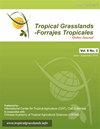The role of leucaena in cattle fattening and breeding production systems in Eastern Indonesia
IF 0.7
4区 农林科学
Q3 AGRICULTURE, DAIRY & ANIMAL SCIENCE
引用次数: 0
Abstract
Cattle farming in West Nusa Tenggara province, Indonesia (NTB) is essential to support the high demand for beef cattle in Indonesia. Leucaena was introduced to smallholders as a high-quality feed to increase cattle production in NTB. A survey was conducted with both leucaena-using and non-leucaena-using smallholder cattle farmers in Sumbawa and West Sumbawa districts, NTB to understand the role of leucaena in NTB smallholder cattle enterprises (mixed breeding/fattening) and the effect of leucaena toxicity on cattle performance, especially cow-calf production. We found that farmers using leucaena feeding systems were able to keep more cattle than farmers using a traditional feeding system (9.1 vs 6.1 head/household). Many leucaena-using farmers (50.1 %) use leucaena for fattening cattle only. Other cattle classes (growers, breeding cows and bulls) were fed leucaena strategically, such as during the dry season (59 % of leucaena-using farmers) and at specific stages of pregnancy and lactation (41 % of leucaena-using farmers). Leucaenausing farmers in rainfed areas planted more leucaena (4,500 vs 1,984 trees) and fattened more bulls (5.8 vs 3.5 head/ household) than farmers in high-rainfall areas. Transmigrant Balinese farmers planted significantly more leucaena trees (7,500 vs 2,354 trees) and raised more fattening bulls (7.8 vs 3.7 head/household) than the local Sumbawanese farmers. Most Balinese farmers had been practising leucaena feeding systems since they migrated to Sumbawa, for a long as 3 decades. Most leucaena-using farmers (74 %) had observed symptoms of illness associated with leucaena toxicity in their cattle such as hair loss and salivation. Few farmers feeding leucaena to breeding cows (5 %) reported instances of reproductive failure. Almost all non-leucaena-using farmers (93 %) reported symptoms of illnesses associated with plant toxicities (among other potential causes), most commonly skin lesions, diarrhoea, cataract, and listlessness. It was concluded that the priority use of leucaena in Sumbawa was for fattening cattle rather than breeding cattle. Leucaena supports smallholder farmers in Sumbawa to have more intensive, productive and income-earning cattle enterprises, but questions remain over whether it should be used for feeding breeding cows.印尼东部亮氨酸在养牛和育种生产系统中的作用
印度尼西亚西努沙登加拉省(NTB)的养牛业对于支持印度尼西亚对肉牛的高需求至关重要。牛角草作为一种高质量饲料被引入到小农中,以提高NTB的牛产量。本研究对北塔布省松巴瓦县和西松巴瓦县使用和不使用青霉烯的小农养牛户进行了调查,以了解青霉烯在北塔布省小农养牛业(混合养殖/育肥)中的作用,以及青霉烯毒性对牛生产性能,特别是犊牛产量的影响。我们发现,使用leucaena饲养系统的农民比使用传统饲养系统的农民能够饲养更多的牛(9.1头/户vs 6.1头/户)。许多使用银粉的农民(50.1%)仅将银粉用于养牛。其他牛类(种植户、种牛和公牛)则在旱季(59%的使用银杏叶的农民)和怀孕和哺乳的特定阶段(41%的使用银杏叶的农民)有策略地饲喂银杏叶。雨养地区种植银合欢树的农民比高降雨量地区的农民种植了更多的银合欢树(4500棵对1984棵),养肥了更多的公牛(5.8头对3.5头/户)。与当地的sumbawan农民相比,迁移的巴厘农民种植了更多的leucaena树(7,500棵对2,354棵),并饲养了更多的肥牛(7.8头对3.7头/户)。自从他们迁移到松巴哇以来,大多数巴厘农民已经实践了长达30年的leucaena喂养系统。大多数使用银粉的农民(74%)观察到他们的牛出现与银粉毒性有关的疾病症状,如脱发和流涎。很少有农民给种牛喂羊角藻(5%)报告了繁殖失败的情况。几乎所有不使用银带的农民(93%)报告了与植物毒性(以及其他潜在原因)相关的疾病症状,最常见的是皮肤损伤、腹泻、白内障和精神萎靡。综上所述,松巴哇地区的白毛菊优先用于育肥牛而非种牛。Leucaena支持Sumbawa的小农拥有更集约化、生产率更高、收入更高的养牛企业,但是否应该用于喂养种牛的问题仍然存在。
本文章由计算机程序翻译,如有差异,请以英文原文为准。
求助全文
约1分钟内获得全文
求助全文
来源期刊

Tropical Grasslands-Forrajes Tropicales
Agricultural and Biological Sciences-Agronomy and Crop Science
CiteScore
1.60
自引率
0.00%
发文量
36
审稿时长
16 weeks
期刊介绍:
The Journal publishes, in English or Spanish, Research Papers and Short Communications on research and development, as well as contributions from practitioners (Farmer Contributions) and Review Articles, related to pastures and forages in the tropics and subtropics. There is no regional focus; the information published should be of interest to a wide readership, encomprising researchers, academics, students, technicians, development workers and farmers.
In general, the focus of the Journal is more on sown (''improved'') pastures and forages than on rangeland-specific aspects of natural grasslands, but exceptions are possible (e.g. when a submission is relevant for a particularly broad readership in the pasture and forage science community).
The Journal will also consider the occasional publication of associated, but closely related, research in the form of an additional scientific communication platform [e.g. a re-make of the former Genetic Resources Communication series of the former Division of Tropical Crops and Pastures of the Commonwealth Scientific and Industrial Research Organisation (CSIRO), Australia].
Areas of particular interest to the Journal are:
Forage Genetic Resources and Livestock Production[...]
Environmental Functions of Forages[...]
Socio-economic Aspects[...]
Topics within the aforementioned areas may include: Diversity evaluation; Agronomy; Establishment (including fertilization); Management and utilization; Animal production; Nutritive value; Biotic stresses (pests and diseases, weeds); Abiotic stresses (soil fertility, water, temperature); Genetics and breeding; Biogeography and germplasm collections; Seed production; Ecology; Physiology; Rhizobiology (including BNF, BNI, mycorrhizae); Forage conservation; Economics; Multilocational experimentation; Modelling.
 求助内容:
求助内容: 应助结果提醒方式:
应助结果提醒方式:


